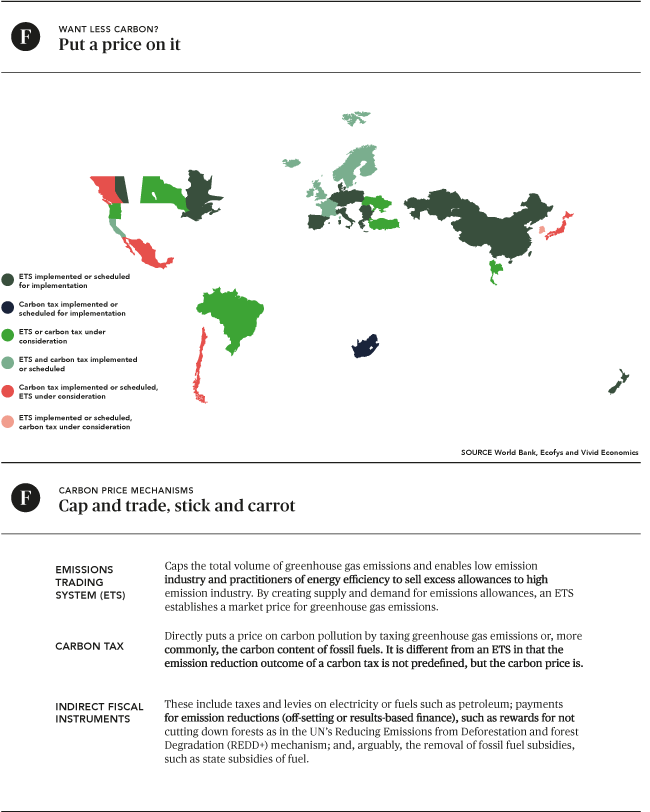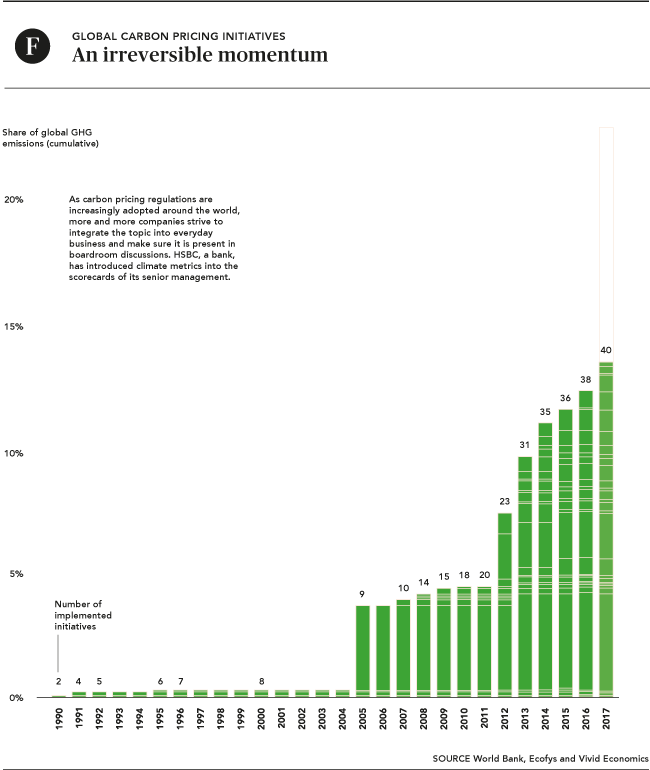CARBON PRICE CORRECTION
China’s roll-out of its emission trading system this year doubles the combined size of all existing markets for carbon credit trade. Helped along by a market-coupling mechanism introduced under the UN’s Paris Agreement, a global carbon price with bite may yet transpire
Policy initiatives that put a price on the environmental cost of carbon emissions have doubled in number since 2010. The World Bank now estimates that 40 national and over 20 sub-national jurisdictions, responsible for almost one-fourth of global greenhouse gas emissions, currently place a price on carbon or will do so in 2017.
China’s decision to roll out its national Emissions Trading System (ETS) this year has much to do with the leap in volume. The Chinese carbon market, with emission allowances backdated to January 1 for those taking part, is expected to be twice the size of the EU-ETS and greater than all existing carbon markets combined.
“As such it will likely set the de facto globalfloor price for carbon and could change theentire political landscape for putting a price on CO2 pollution.”
Carbon is priced under a range of policy measures. As well as the creation of ETS markets for the trade of carbon credits, these include carbon taxation and indirect levies on polluting behaviour, such as destroying forests that would otherwise absorb CO2 (see box on next page). The aim is to monetise the damage caused by greenhouse gases, making it financially attractive to reduce them.
During the 1990s carbon taxes were placed on fuel prices in countries such as Finland (1990), Sweden (1991), and Denmark (1992). A second wave of initiatives after 2005 saw the creation of markets for carbon trade that put a price on carbon emission allowances, or credits, the biggest being Europe’s ETS.
The era when carbon pricing was limited to rich north European countries with progressive environmental governance is long gone. The concept has spread to a wide variety of countries (see graph page 64). In addition, nearly 500 companies have adopted some form of internal carbon pricing. Jeff Swartz, Managing Director of the International Emissions trading Association argues that carbon pricing is no longer just an OECD-led policy construct, but one in which emerging economies are actively taking part.
GET THE PRICE RIGHT
China and other countries can learn important lessons from the EU-ETS experience, where the issue of a surplus of emissions allowances, caused by overestimating demand, has consistently prevented the market from setting robust carbon prices. Much of the blame for disablement of the price signal is placed on the global slow down in industrial activity after the 2008 global crisis. The over-supply of emission allowances equalled the total EU emissions released over a year.
The EU-ETS price has mainly fluctuated around €5 a tonne of CO2, considerably lower than the expected €30. Difficulties in predicting the long term price in an ETS market is problematic for business. Many argue that insertion of a price floor could offer some comfort to investors.

CONNECTING THE DOTS
Fragmentation of the global market for carbon into a plethora of different regional market designs and sizes is a key challenge for the development of a global price. Responding to the challenge, the United Nations Paris Agreement on climate change, which came into force in November 2016, provides a basis for connecting the subnational, national, regional and international carbon pricing initiatives through Internationally Transferred Mitigation Outcomes (ITMOs). Under the ITMO process, countries can trade carbon certificates internationally to help them meet their nationally determined contributions to global emission reductions, while avoiding double counting. Another idea promoted by the World Bank is carbon clubs (or border carbon adjustments). Members of such clubs agree on a specific carbon pricing system.
Despite the current momentum in carbon pricing there is a long way to go. On the global fiscal scales, subsidies flowing out to support fossil fuel energy greatly outweigh revenues coming in from carbon taxes and emissions trading systems.
Carbon pricing also has its share of critics. A common complaint is that while carbon pricing can work to reduce energy consumption and waste, it cannot replace more direct support of particular technologies, such as renewable energy, if these are to expand at the rate required. Another criticism is that the carbon tax rate or emissions cap are too low to provide adequate compensation for the economic consequences of climate change. A recent report on the cost to society of carbon pollution, from the US National Academy of Sciences, indicates that the prices on carbon set by markets is far too low. The price of a ton of CO2 should be around $62, it suggests. •

TEXT Tobias Nielsen & Jakob Skovgaard